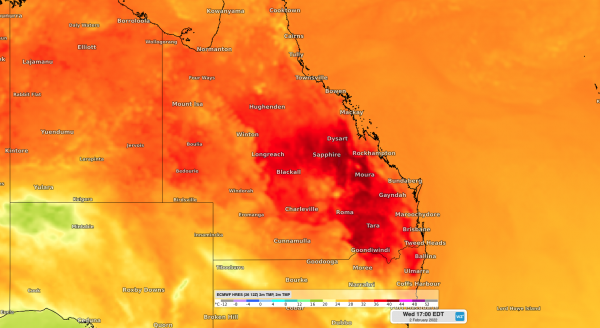A mass of extremely hot and humid air will cause oppressive conditions in southeast Queensland in the middle of next week.
A pool of hot air originating over western Queensland will be pushed over the state’s southeast in the middle of next week.
While bursts of hot weather are common in southeast Queensland during summer, next week’s heat will be accompanied by abundant atmospheric moisture and high relative humidity.
The result of this hot and muggy air will be two days and nights of oppressive warmth, which will make it more difficult than usual for the body to cool down from sweating.
Images: Forecast surface air temperature during the afternoon on Tuesday (top) and Wednesday (bottom), according to the ECMWF model.
Maximum temperatures should reach about 33 to 35ºC on Tuesday and Wednesday, respectively. However, the high humidity will make it feel about 3 to 5ºC warmer than this.
Afternoon sea breezes and potential shower activity will provide some relief from the heat, however the high humidity will continue to make it continue to feel muggy well into the night.
While minimum temperatures should drop to about 22 to 23ºC on Monday and Tuesday nights, models suggest that temperatures will still be feeling like the mid-to-high twenties on both nights.
The heat and humidity will be flushed out of southeast Queensland on Thursday, February 3rd by a welcome southerly change. Maximum temperatures are expected to stay below 30ºC from Thursday until at least the start of the following week. For more information on Weatherzone’s energy forecasting, please contact us at apac.sales@dtn.com.








